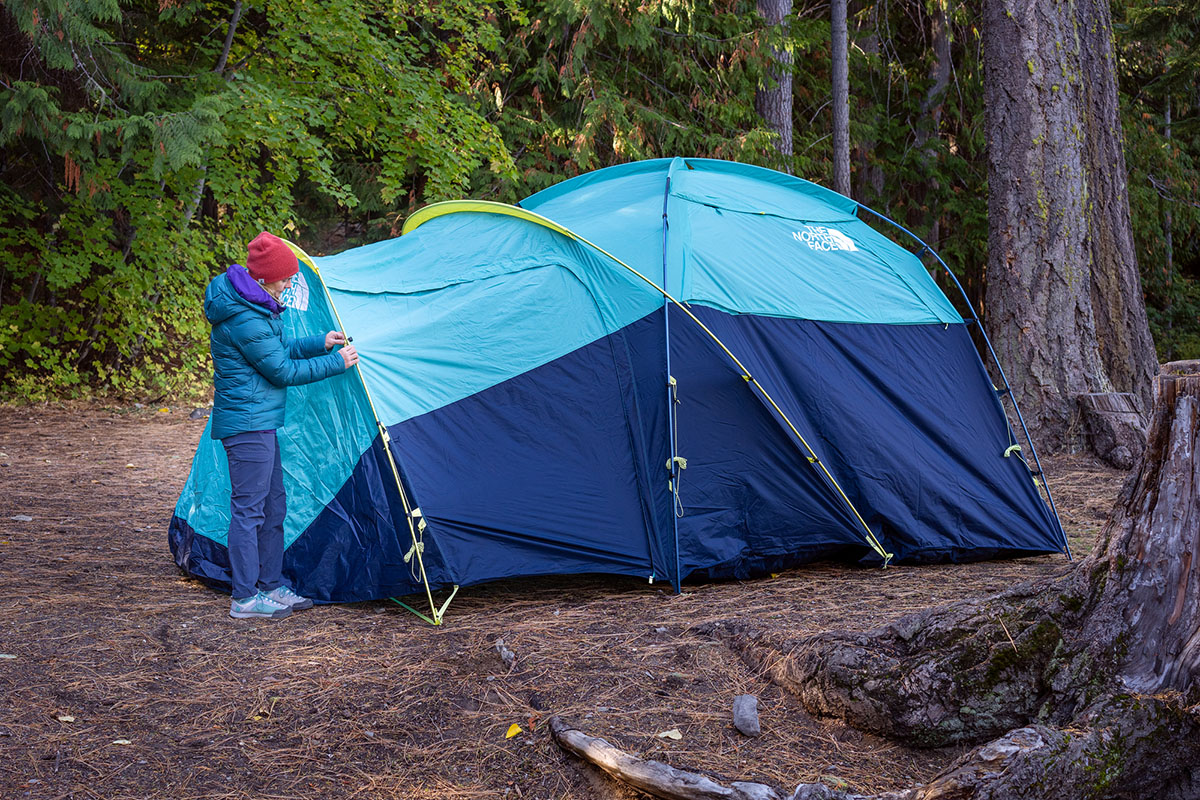
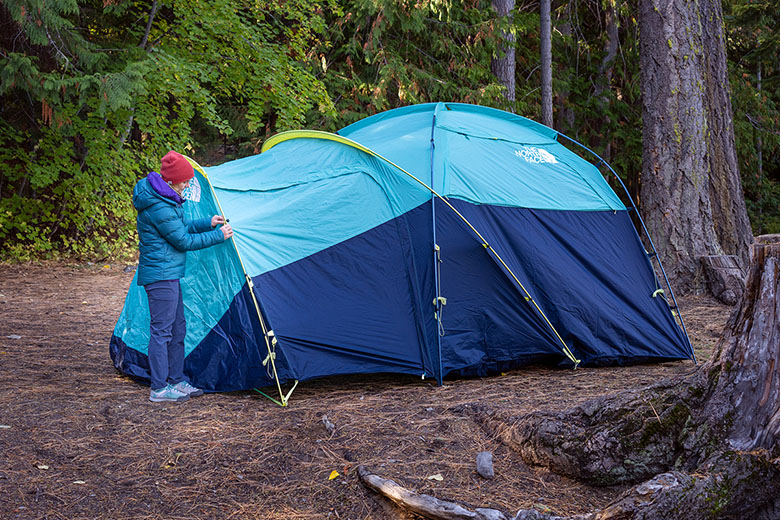
Price: $500
Floor area: 86.1 sq. ft.
Peak height: 76 in.
Weight: 20 lb. 15 oz.
Capacities: 4P, 6P
What we like: Extremely livable with a standing-height interior and massive vestibule at a competitive price.
What we don’t: Time-consuming to set up and not the most storm-worthy design.
See The North Face Wawona 6
The North Face may have more of a reputation for its rugged backcountry offerings than its luxury camping wares, but the palatial Wawona 6 is a shining example of the brand’s varied expertise. The tent is extremely livable—especially with the massive vestibule attached—and overall build quality is top-notch. The set-up process does take some time, and the rainfly only offers partial coverage, but we came away impressed by the tent’s all-around performance after testing it across western Montana. Below we break down our experiences with The North Face Wawona 6. To see how it stacks up to the competition, check out our article on the best camping tents.
Editor's note: The photos included below are of the past-generation Wawona 6, which featured a single-wall design. The latest model features a hybrid double-wall structure with a partial-coverage rainfly but is otherwise largely similar to the prior design. Our review below reflects our experiences with the newest model.
If a home-in-the-woods experience is what you’re after, I'm happy to report that The North Face Wawona 6 feels reminiscent of a small cabin. For starters, the tent’s 76-inch peak height means anyone under 6’4” can stand upright at the center, making it easy for multiple people to move around inside. The 86.1-square-foot floor area is also very generous—for reference, we were able to fit two queen-sized air mattresses side by side with a bit of room to spare. And while the Wawona has more of a traditional dome shape than some competitors, the poles do an overall effective job maximizing headspace by pulling the walls up and away. Sitting in chairs, standing up—heck, even doing yoga with a buddy—it’s all totally feasible inside the Wawona.
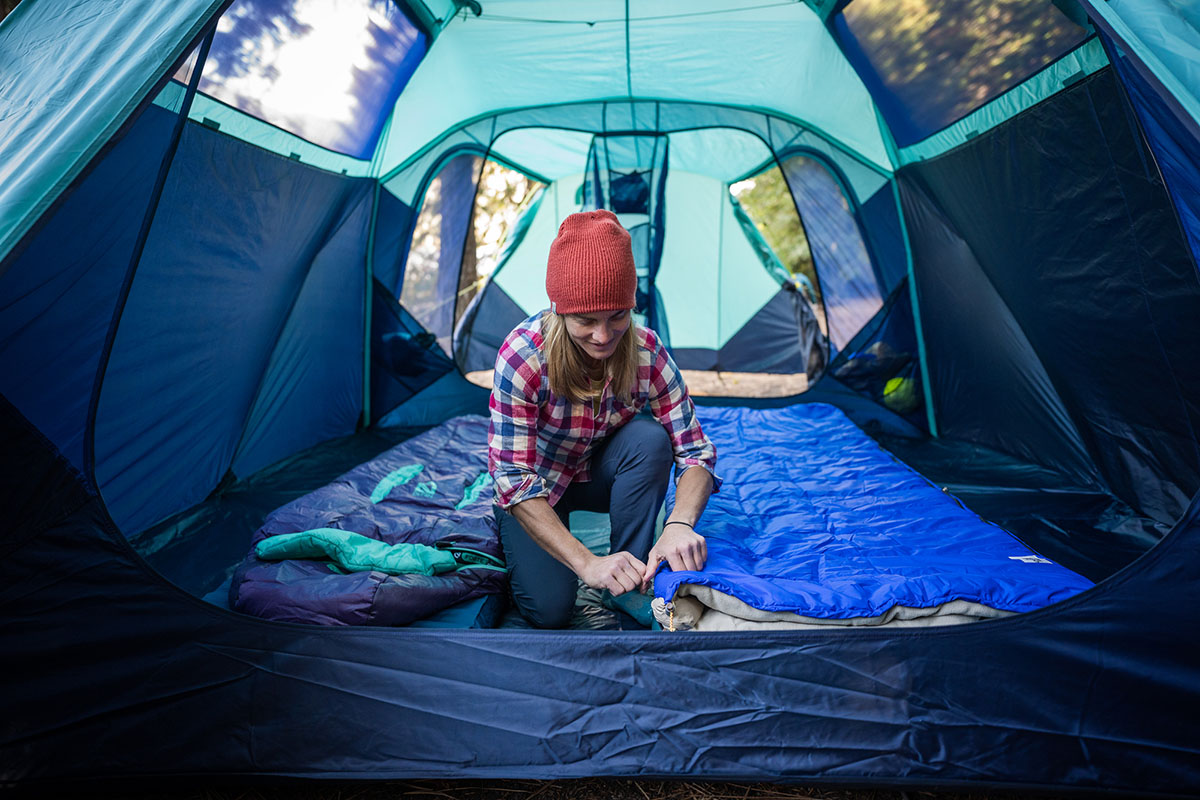
In my experience, the Wawona offers adequate weather protection but is by no means a standout in this department. The biggest culprit is the partial-coverage rainfly, which leaves a good chunk of the lower portion exposed to the elements. I was initially concerned that this would lead to soaking through in heavy or sustained rainfall, but I'm happy to report that these sections are fully waterproof (and coated with polyurethane for added assurance). The back door is also unprotected due to the lack of a vestibule, but again, I've had no issues with leakage throughout testing. It’s a similar story with wind protection: Even on a particularly gusty day that left several camping tents nearby crumpled and flapping in the wind, the Wawona stood strong and showed few signs of weakness. To be clear, it wouldn’t be my first choice in truly gnarly weather due to the upright shape and lack of full-coverage fly, but it’s kept me perfectly dry and protected in mild thunderstorms and moderately strong winds thus far.
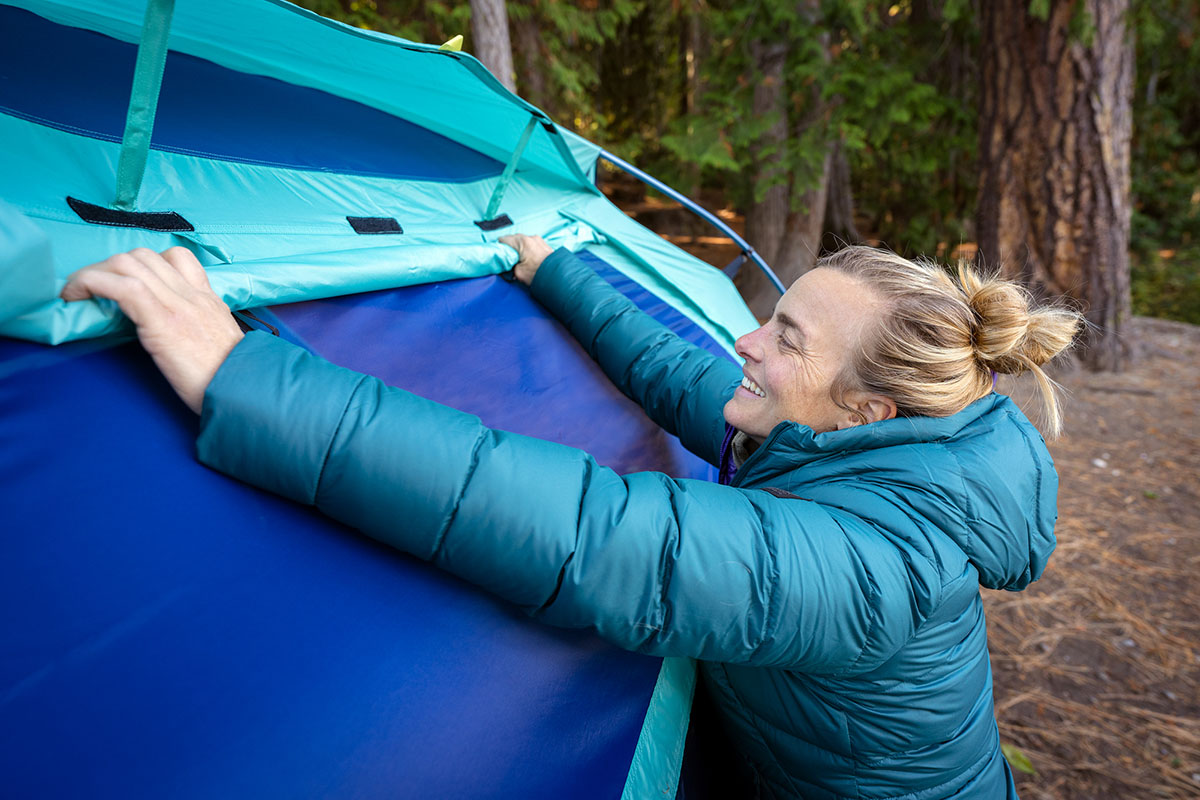
The North Face Wawona 6 features relatively thin (40D) polyester mesh across both doors, part of the roof, and the upper sidewalls, resulting in excellent airflow when the rainfly is not connected. The fly and vestibule certainly seal things up more, although you do get two strutted roof vents you can prop open in inclement weather, and the fly can be rolled back at either side in fair conditions to expose large mesh windows. The large front vestibule also features massive openings along the sides, allowing for nearly unrestricted airflow when opened up while still maintaining protection from light rain and privacy from neighbors. Importantly, with the vestibule at least partially open, we never experienced condensation buildup in the tent despite very warm temperatures during testing.
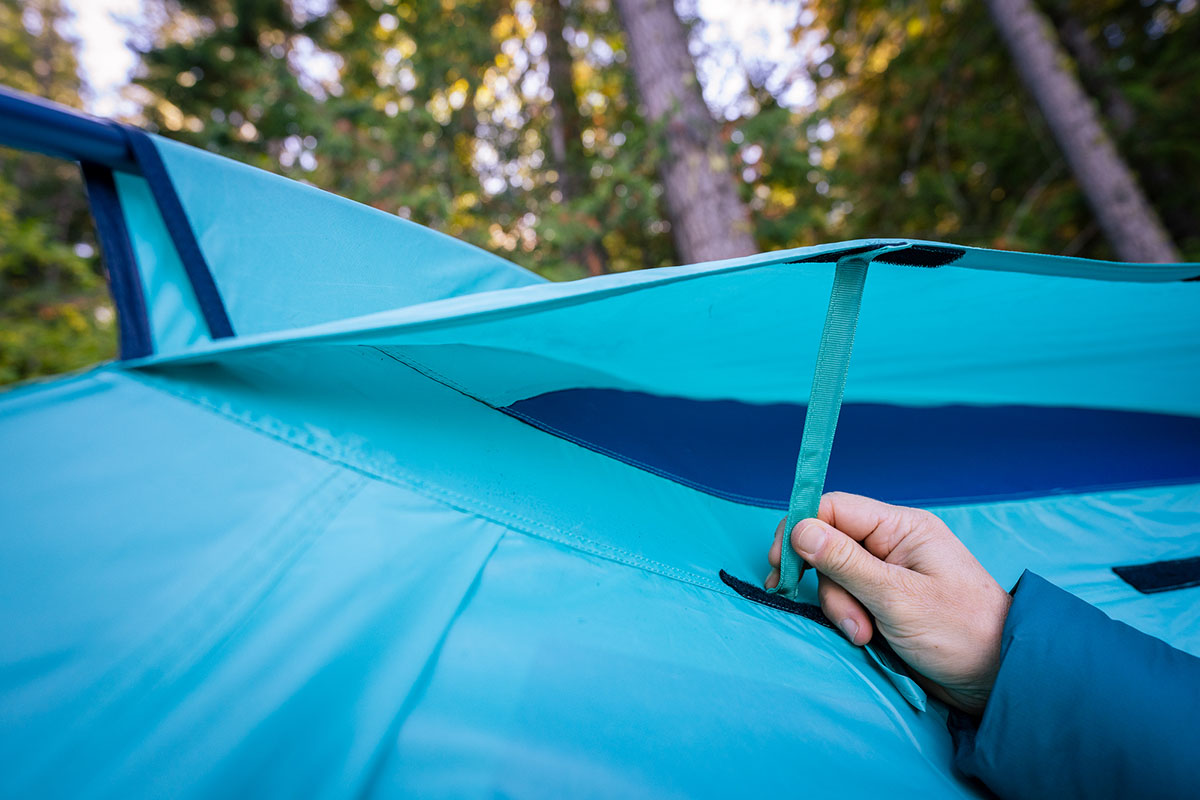
One of the Wawona’s biggest selling points, in my opinion, is its massive front vestibule. Fully extended and staked out, the single vestibule offers a whopping 44.7 square feet of space that’s almost fully enclosed. In other words, you’re essentially getting another three- or four-person tent tacked onto the front door. In testing, I quickly came to love this front patio space and utilized it for everything from gear storage to setting up camp chairs and playing games after long days out. It’s worth noting that many competitors feature two smaller (and often symmetrical) vestibules, but I've personally never felt limited by the Wawona’s single, oversized design.
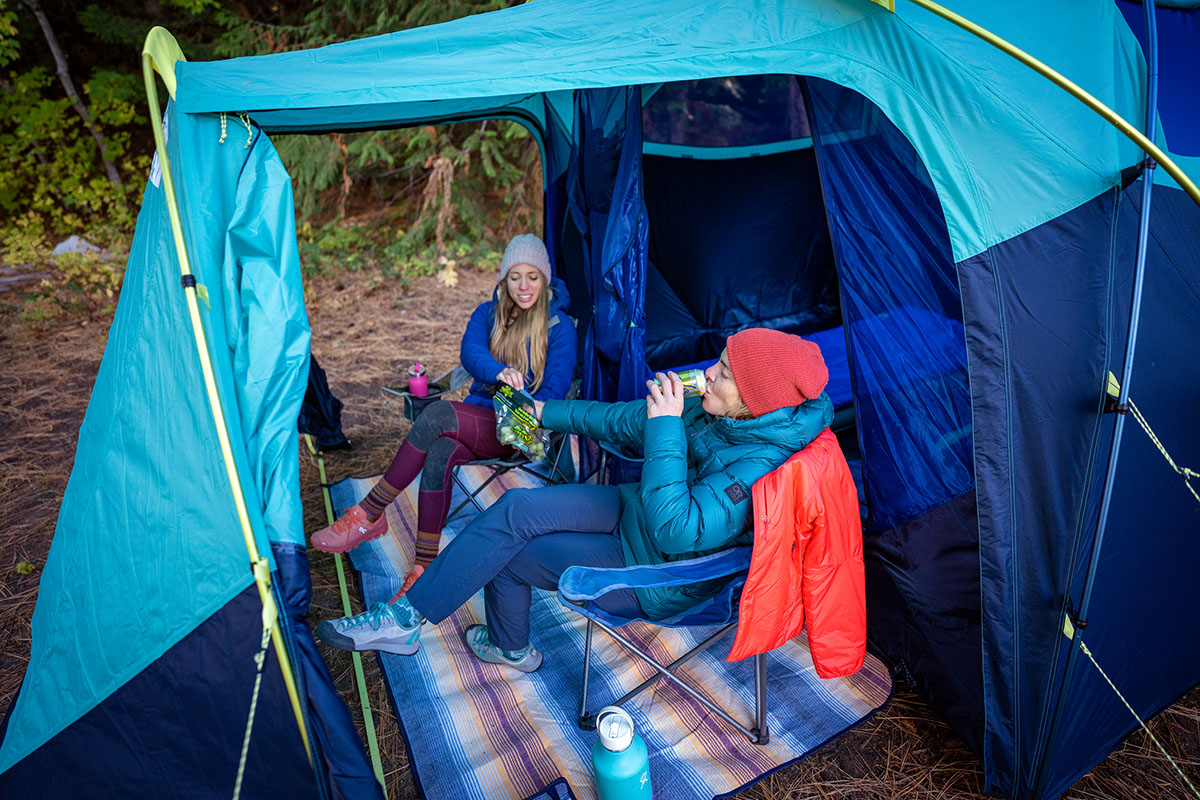
Inside, the Wawona comes decently appointed with four mesh pockets above the rear door and three hanging mesh pockets on the door itself. I found the former large enough to stash all the necessities—from books to playing cards to toiletries—and positioned nicely for staying out of the way with a full house. The mesh pockets on the door are a different story, however. My biggest gripe is that they impede access: If you open the back door with anything inside the pockets, all of the contents will fall out or flop onto the floor. If some of your gear manages to stay put, re-zipping the back door becomes a hassle with the added weight pulling at the seams. To be sure, the storage layout is entirely functional if you don’t use the back door, but that defeats the purpose of buying a two-door camping tent in the first place.
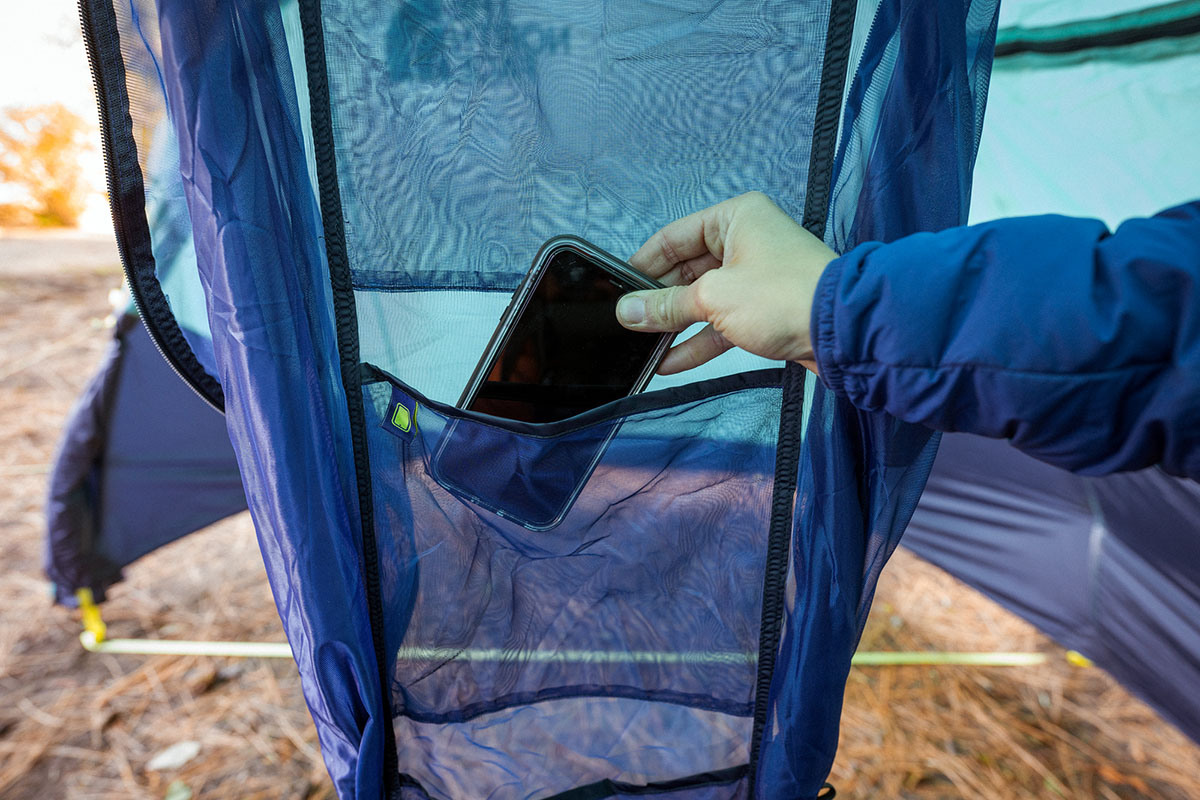
Along with spaciousness, build quality is another place where the Wawona earns its price tag. In terms of fabric thickness, The North Face opted for robust 150-denier (D) polyester along the floor, along with thinner—but still very substantial—75D along the canopy and rainfly. All three components are also treated with a polyurethane coating for added wet-weather protection. And importantly, the rest of the design has a similarly high-quality and hardwearing feel, from the strong DAC aluminum poles to the smooth-operating zippers. It’s worth noting that The North Face does sell a separate footprint for the tent, which can be a worthwhile investment if you frequently camp on rough surfaces like rock, but the 150D floor should hold up well on its own, provided you exercise reasonable caution. In fact, after a full summer of use in dispersed campgrounds across Montana, my tent is showing no signs of wear, and I expect it to last many more seasons without issue.
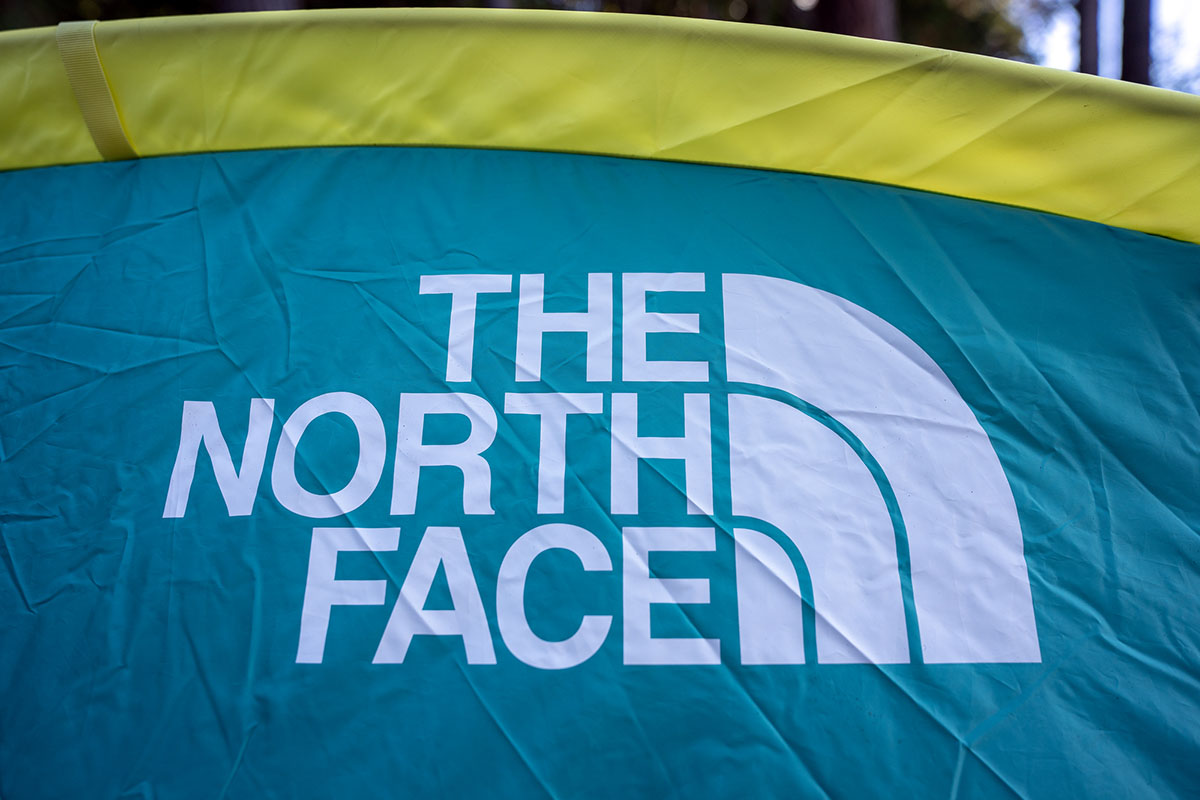
There’s no getting around it: At more than 20 pounds all in, the Wawona is unapologetically hefty and bulky. That said, the weight likely won’t be an issue for most car campers sticking close to their vehicle, and it’s not too far off from popular alternatives like Nemo’s Aurora Highrise 6P (18 lb. 10 oz.) and REI Co-op’s Base Camp 6 (20 lb. 11.5 oz.). For many, the bigger problem will be the tent’s large packed size (10 x 32 in.), which takes up a substantial amount of space in a trunk or truck bed. On the bright side, the included carrying bag has two handles that make shuttling short distances easy, and it’s large enough that rolling the tent away is a quick and painless endeavor (some stuff sacks require careful, tight folds). All told, the Wawona certainly wouldn’t be our first choice for weight- or space-conscious adventures, but many comfort-focused campers will find the advantage in livability well worth those trade-offs.
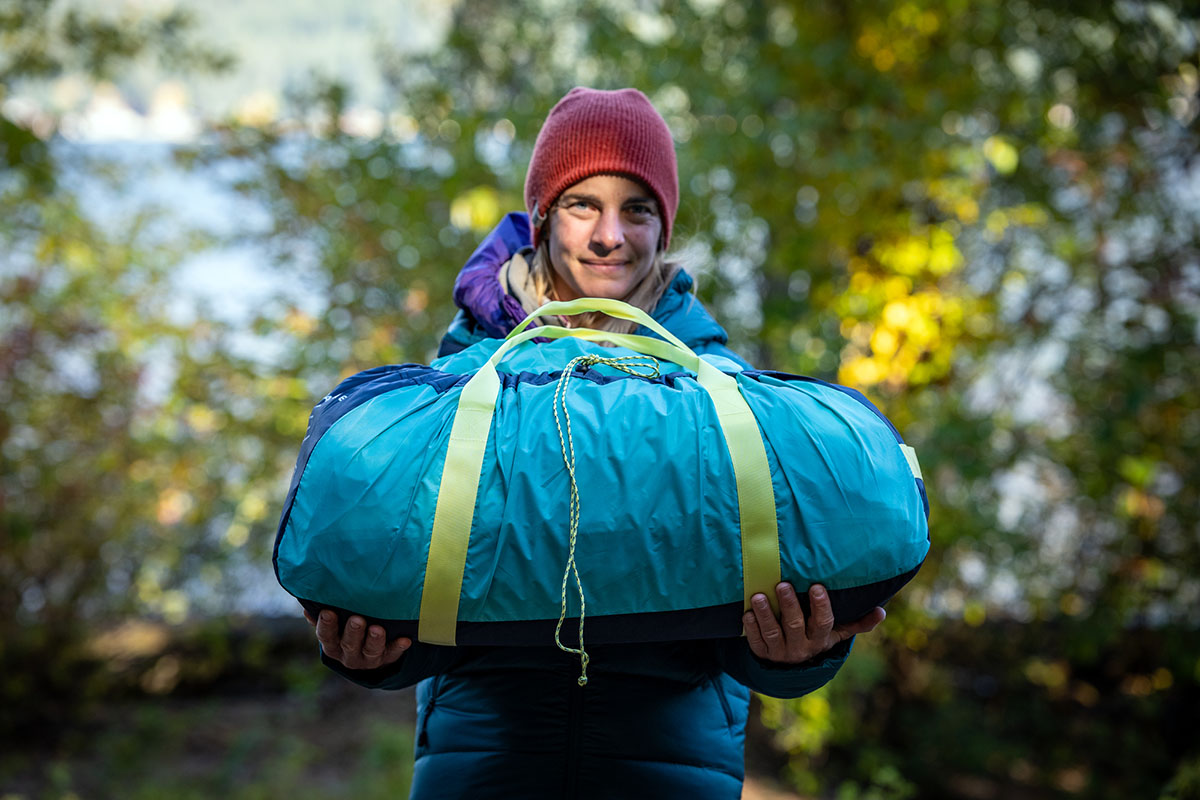
The setup process for The North Face Wawona 6 is relatively straightforward, although there’s a bit of a learning curve initially. To start, lay the tent body on the ground and connect the four pole sections, then thread the two orange poles through the matching sleeves to form an “X” at the top of the tent. I’m admittedly not a huge fan of the sleeves, as they’re more involved and puncture-prone than the standard hooks you get with most tents. They also lead to fabric bunching, which often requires two hands to mitigate. And once you manage to work the poles into the sleeves, securing them in the grommets takes some effort, too. To wrap things up, feed the final pole through the sleeve over the front door. All in all, the process is certainly possible with one person, but I found that it’s much easier with two.
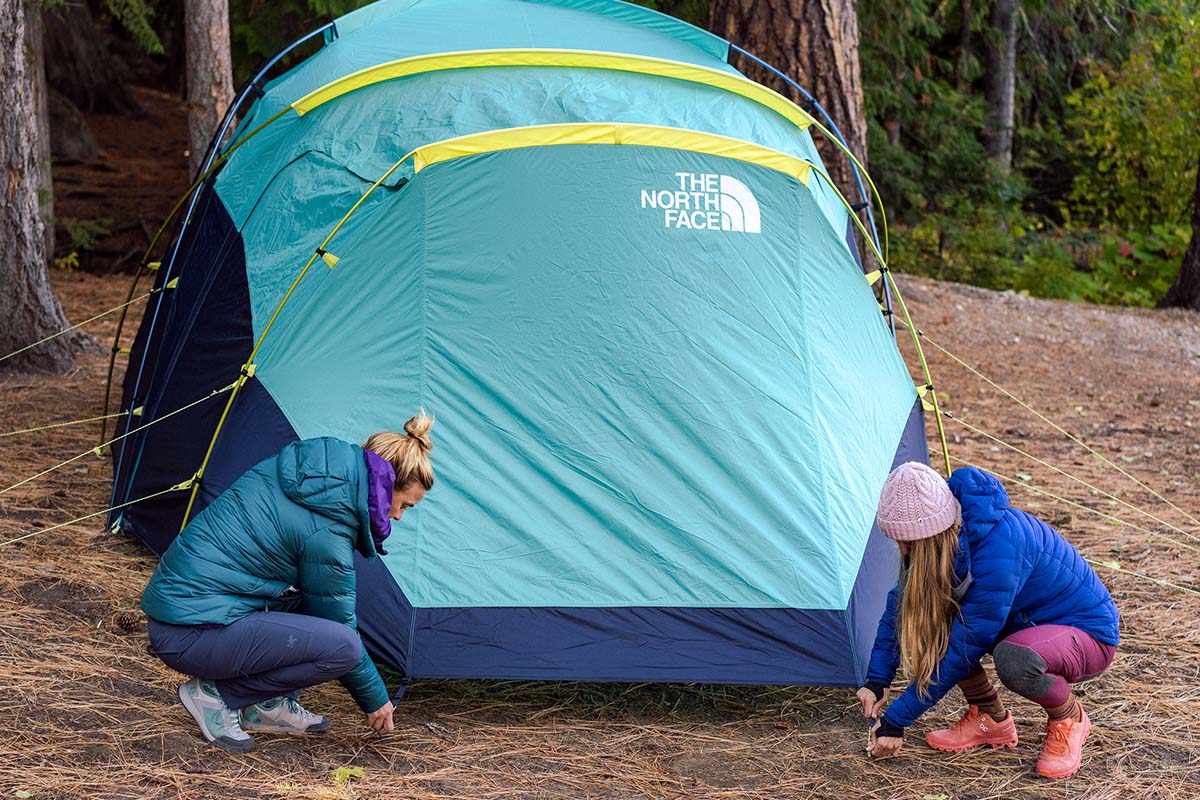
Thankfully, securing the rainfly is a bit easier: Drape the fly over the tent and secure it down with a system of T-shaped attachment points and Velcro straps over the poles. Finally, thread the final pole through the front of the vestibule, stake everything out, and secure the six guylines for added structure. Achieving the proper tension for the vestibule did take a bit of finagling at first, but it’s not overly challenging once you get the hang of it. Taking things down is just a matter of reversing the process—and it’s much easier to remove the poles from their sleeves than it is to thread them through, so there’s a bit of time saved on the back end.
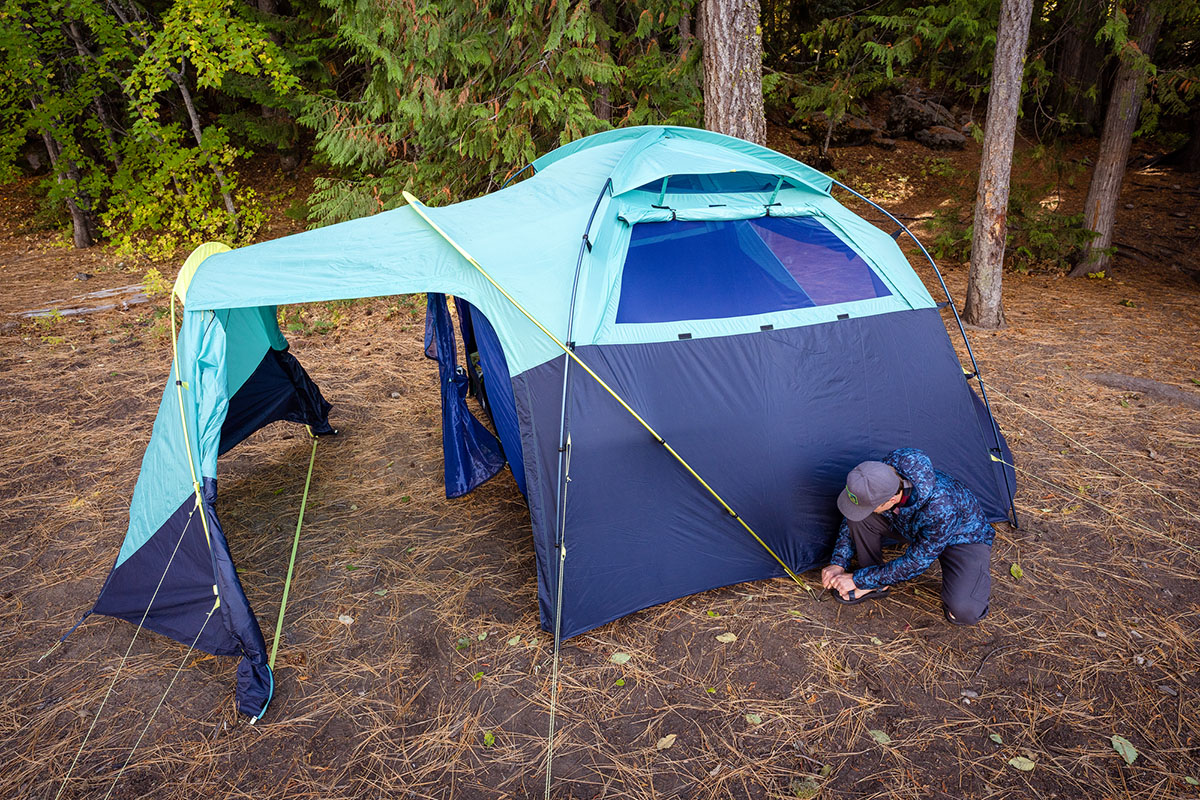
We tested the six-person Wawona for this review, and it’s also offered in a four-person capacity for smaller families and groups. For $100 less than the Wawona 6, the Wawona 4 checks in considerably lighter at 13 pounds, boasts 58.1 square feet of floor space, and has a peak height of 68 inches. It also packs down smaller (10 x 27 in.), although the front vestibule covers just 27.6 square feet and lacks the front porch-like layout of the larger variation. In our opinion, the massive, standing-height vestibule is one of the biggest selling points of the Wawona, making the six-person model an easy favorite. But for smaller families—e.g., a couple with a dog—the four-person Wawona will save you some cash and take up less space when stored.
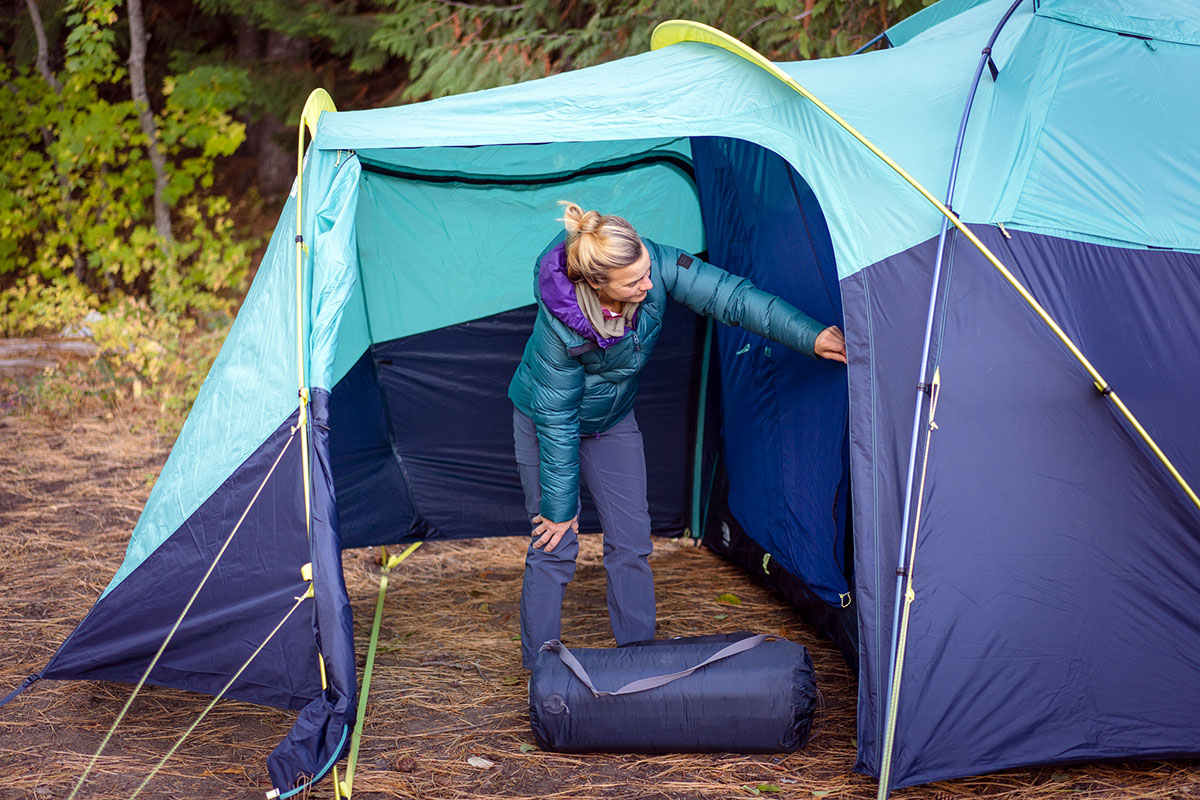
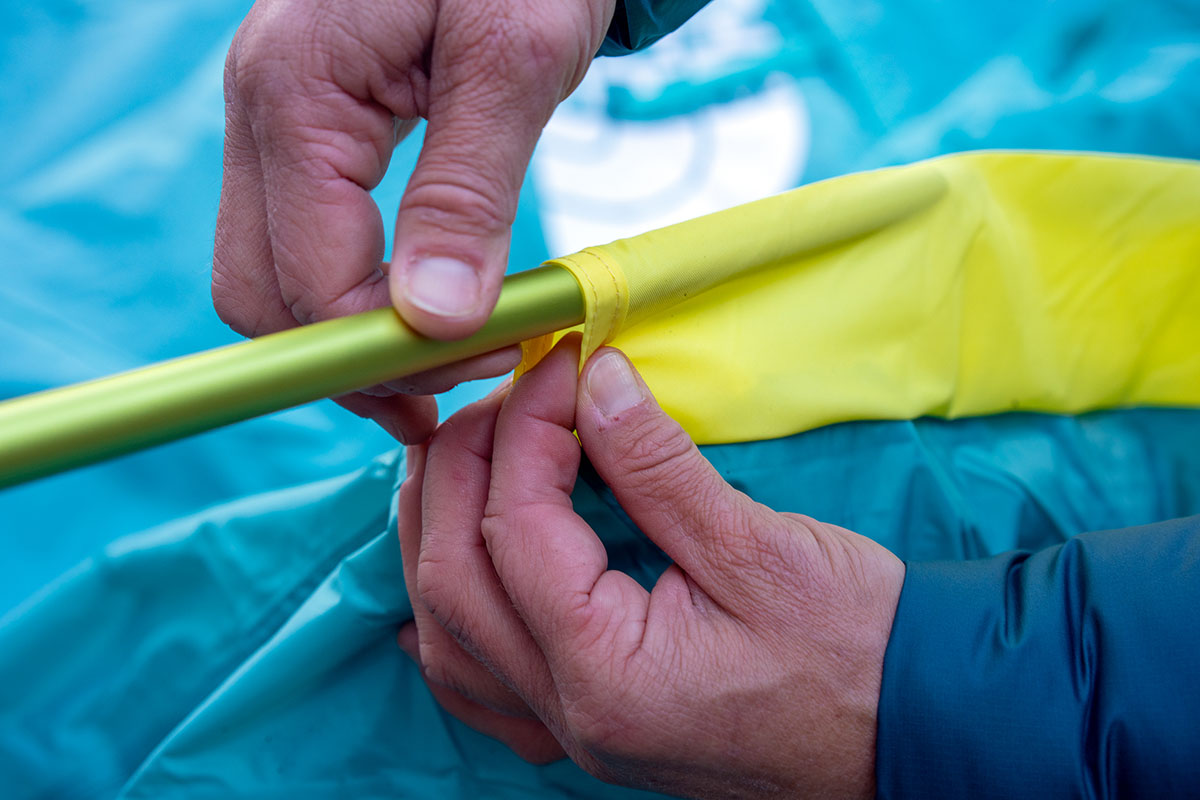
| Tent | Price | Floor | Height | Capacities | Weight | Packed Size | Doors |
|---|---|---|---|---|---|---|---|
| TNF Wawona 6 | $500 | 86.1 sq. ft. | 76 in. | 4P, 6P | 20 lb. 15 oz. | 10 x 32 in. | 2 |
| REI Co-op Wonderland 6 | $499 | 83.3 sq. ft. | 78 in. | 4P, 6P | 22 lb. 15 oz. | 13 x 32 in. | 2 |
| Nemo Aurora Highrise | $500 | 83.3 sq. ft. | 77 in. | 4P, 6P | 18 lb. 10 oz. | 9.5 x 26 in. | 2 |
| Marmot Limestone 6P | $529 | 82.9 sq. ft. | 76 in. | 4P, 6P | 17 lb. 0 oz. | 10.4 x 24.4 in. | 2 |
| Coleman Skydome 6P | $150 | 85.0 sq. ft. | 72 in. | 2P to 12P | 16 lb. 0 oz. | Unavailable | 1 |
The North Face Wawona 6 puts it all together extremely well, including excellent livability, ventilation, and durability, earning it our vote as the best camping tent this season. But there’s certainly no shortage of options to choose from, and another staff favorite is REI Co-op’s Wonderland 6. For essentially the same price, the Wonderland is a little taller at 78 inches, features similarly durable fabrics and components, and stacks up competitively in floor area (83.3 sq. ft.). However, in addition to weighing a little more, the Wonderland lacks a functional rainfly—there are narrow awnings above each door—and omits vestibules. REI does sell a Mud Room attachment that functions similarly to the Wawona’s included front vestibule, but it will run you an additional $99. With that in mind. The North Face Tent strikes us as the better overall value, but both are extremely livable and high-quality camping tents.
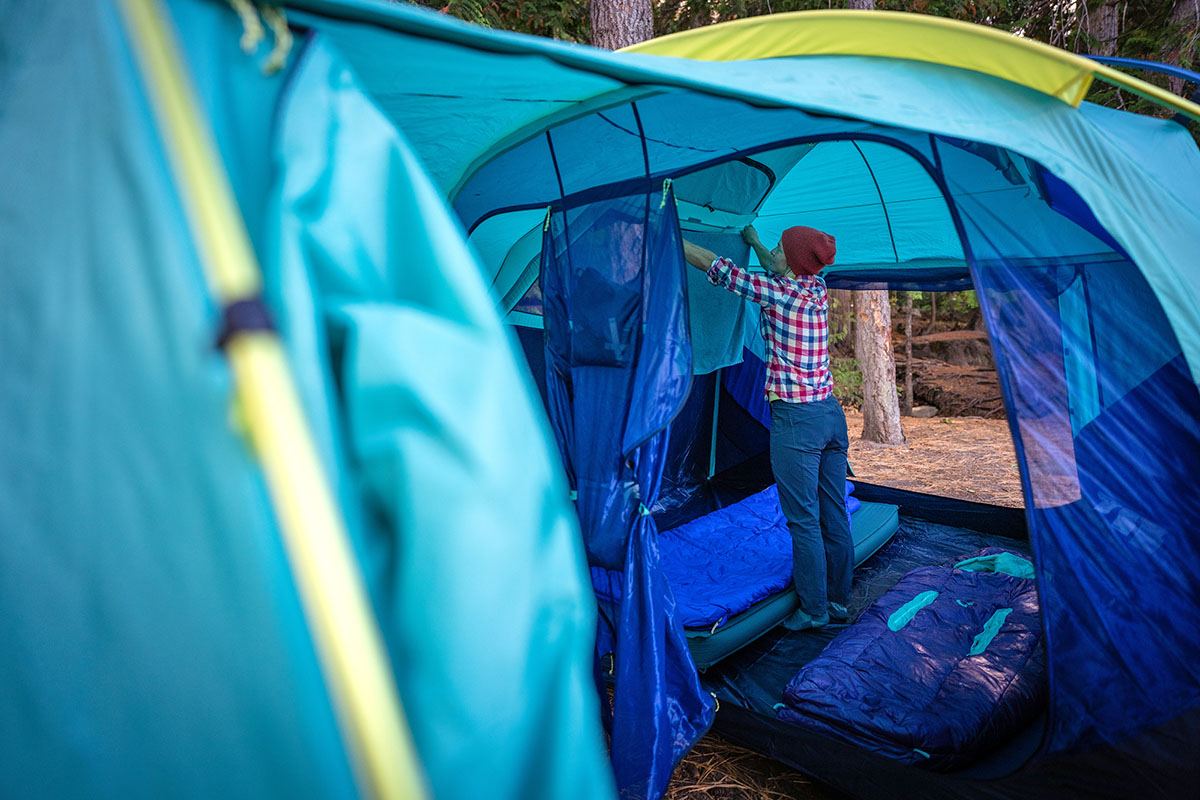
Another luxurious tent we love is Nemo’s Aurora Highrise 6P. For the same price as the Wawona, the Aurora Highrise is similarly tall, with a peak height of 77 inches, and uses comparably thick fabrics throughout. It’s also a little lighter than the Wawona 6 at 18 pounds 10 ounces all in and packs down smaller (9.5 x 26 in.), although the 83.3-square-foot interior is a bit smaller than the Wawona’s 86.1-square-foot floor plan. What’s more, the Aurora’s sloped roof sacrifices some headroom along the sides, resulting in a noticeably less spacious feel inside. And while the Nemo features two generously sized vestibules (23.6 sq. ft. each), we personally prefer the versatility of the Wawona’s single oversized vestibule, which allows for standard gear storage or use as a shaded hangout area. The Aurora is easier to set up and decidedly well built, but we think the Wawona puts it all together a little better (for more info, check out our in-depth Aurora Highrise review).
Next up, Marmot’s Limestone 6P offers a very comparable package for about $30 more than the Wawona. The tent’s 76-inch peak height and pre-bent poles create a similarly spacious feel inside, and its 82.9 feet of floor space is ample for families. The biggest difference is the coverage of the rainfly: While the Wawona’s leaves much of the bottom of the tent exposed, the Marmot’s extends almost to the ground. This is good news for storm protection but does detract from overall ventilation. Also, while the Marmot’s vestibules provide a generous amount of external storage (40.9 sq. ft.), they’re no match for the spacious front porch area you get with the Wawona. For $29 less, we think most campers will be happier with The North Face tent.
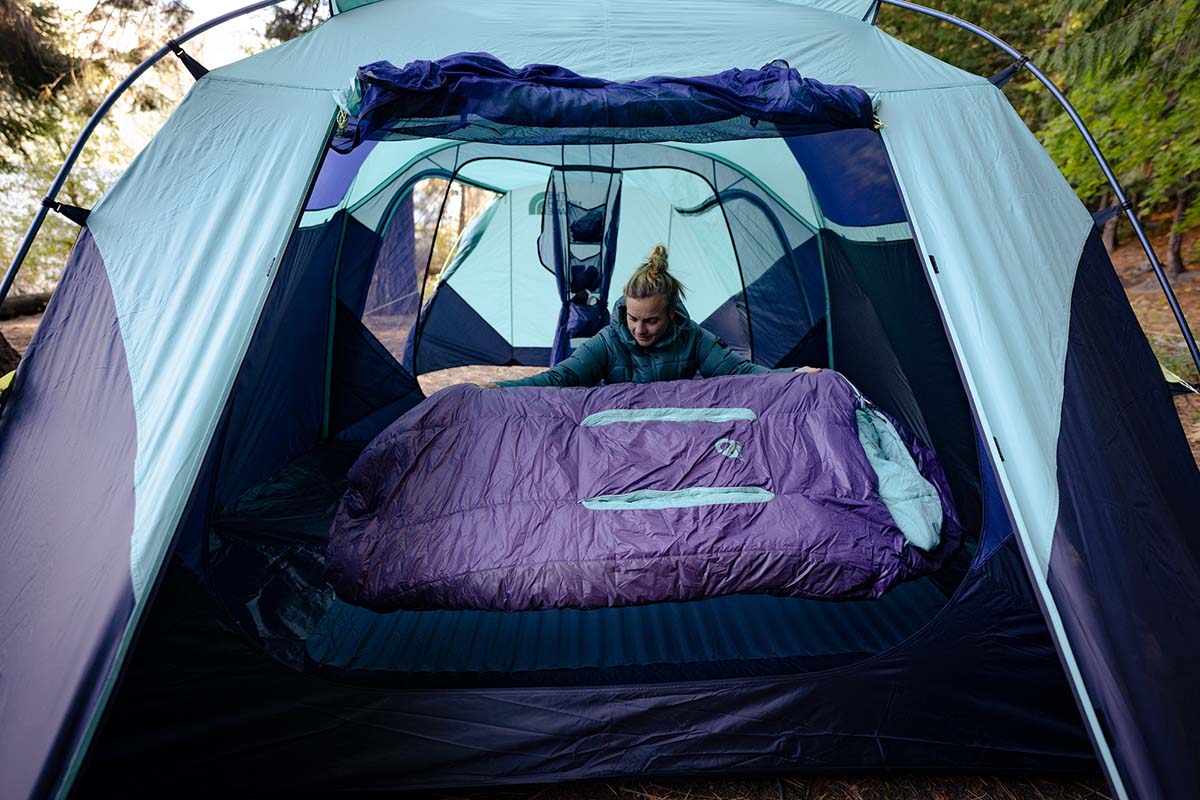
Finally, for budget-conscious campers or those who only get out occasionally, it’s hard to beat Coleman’s wallet-friendly Skydome 6P. For just $150 full price and often available on Amazon for less, the Skydome is very livable with an 85-square-foot interior and 72-inch peak height. It also checks in around 4 pounds lighter than the Wawona and is considerably faster to set up thanks to its simplified pole structure. However, you can expect to make considerable sacrifices at this price: The Coleman only features one door—which makes it much tougher for multiple people to enter and exit the tent—and features noticeably cheaper materials that won’t hold up as well over the long term. The rainfly also offers limited coverage, even compared to the Wawona. In other words, we think committed campers will find the added investment well worth it, but the Skydome is perfectly serviceable for infrequent use in fair weather.